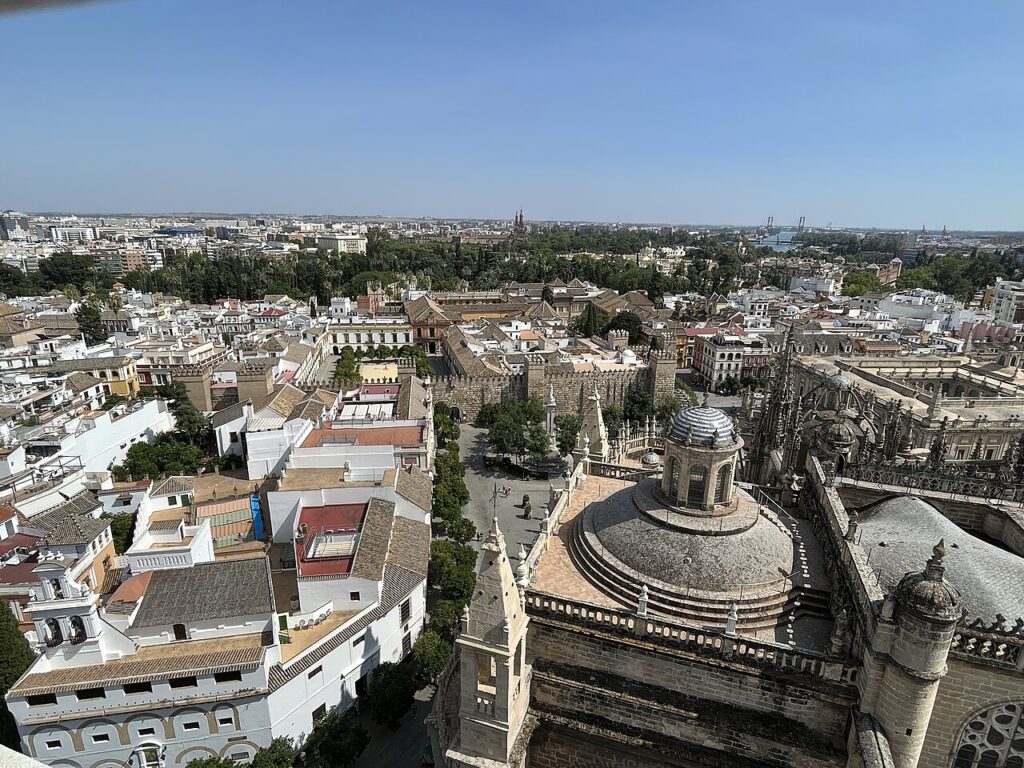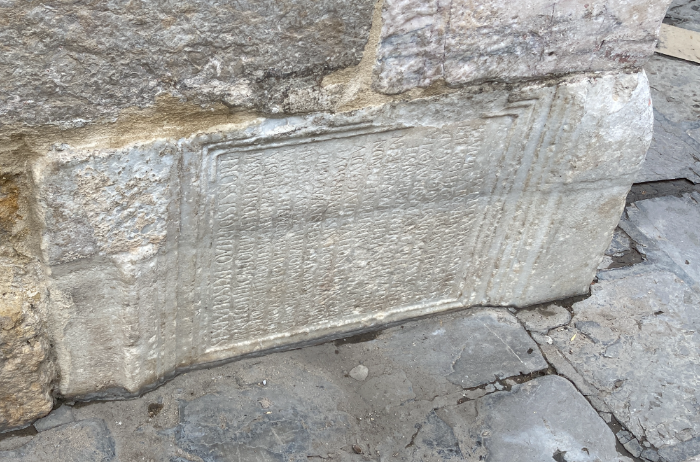Architecture of Seville, Andalusia, Spain
Seville is the capital of the Spanish region known as Andalusia. The city exchanged hands many times, beginning with the Romans, then the Visigoths, then the Moors, and finally the Spanish Kingdoms. Each of these rulers left its mark on Seville’s impressive buildings. Seville contains an interesting blend of Moorish Architecture mixed with Gothic & Baroque Architecture. Seville prospered as a major trading port throughout the Spanish Golden Age but saw economic decline during the downfall of the Spanish Empire. Seville hosted the Ibero-American Exposition of 1929 at which point the city constructed dozens of impressive monuments. Today, Seville is one of Spain’s most popular destinations, and its blend of various architectural styles makes it an incredible place to visit.

Map of Seville

Map of Seville highlighting some of the city’s main attractions.
1. La Giralda & Seville Cathedral
2. The Royal Alcazar of Seville
3. Plaza de España
4. Torre del Oro
5. General Archive of the Indies
Table of Contents
History of Seville
Unifying Elements in Sevillian Architecture
Moorish Influence

Many of Seville’s buildings contain a strong influence from Moorish Architecture. Both the historic and contemporary buildings of Seville share this trait. Geometric Patterns, muqarnas, horseshoe arches, and other elements from Islamic Architecture can be found in the Architecture of Seville. Seville also contains a lot of Mudejar buildings, which blend Moorish and European design elements.
The Golden Age of Seville
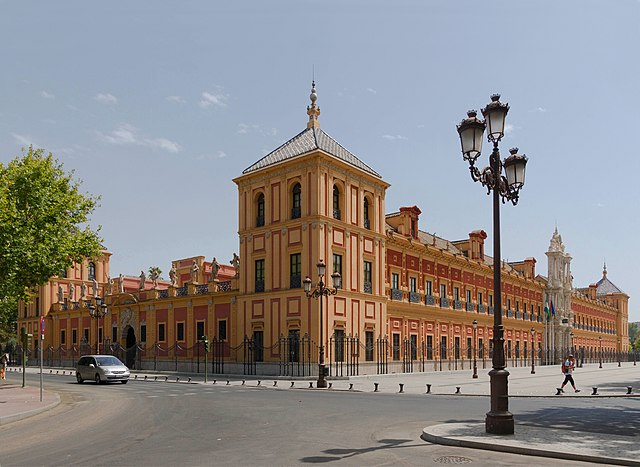
Remnants of Seville’s Golden Age can be found throughout the entire city. Structures like the Palace of St Telmo and the General Archive of the Indies all date to when Seviille profited heavily from foreign trade. Goods such as coffee, gold, spices, tobacco, and chocolate were all making their way through Seville and beyond to the rest of Spain. Some buildings, such as the Royal Tobacco Factory, were specifically constructed to assist with the trade influx.
Orange Trees

Orange Trees are another element found throughout the architecture of Seville. Oranges have been cultivated in and around Seville for thousands of years, and today some of the world’s best oranges come from southern Spain. Orange Trees can be found in many public squares and streets in Seville, particularly in the neighborhood of Santa Cruz. The image above shows a famous batch of trees within the Courtyard of the Oranges at Seville Cathedral.
Built for the Heat
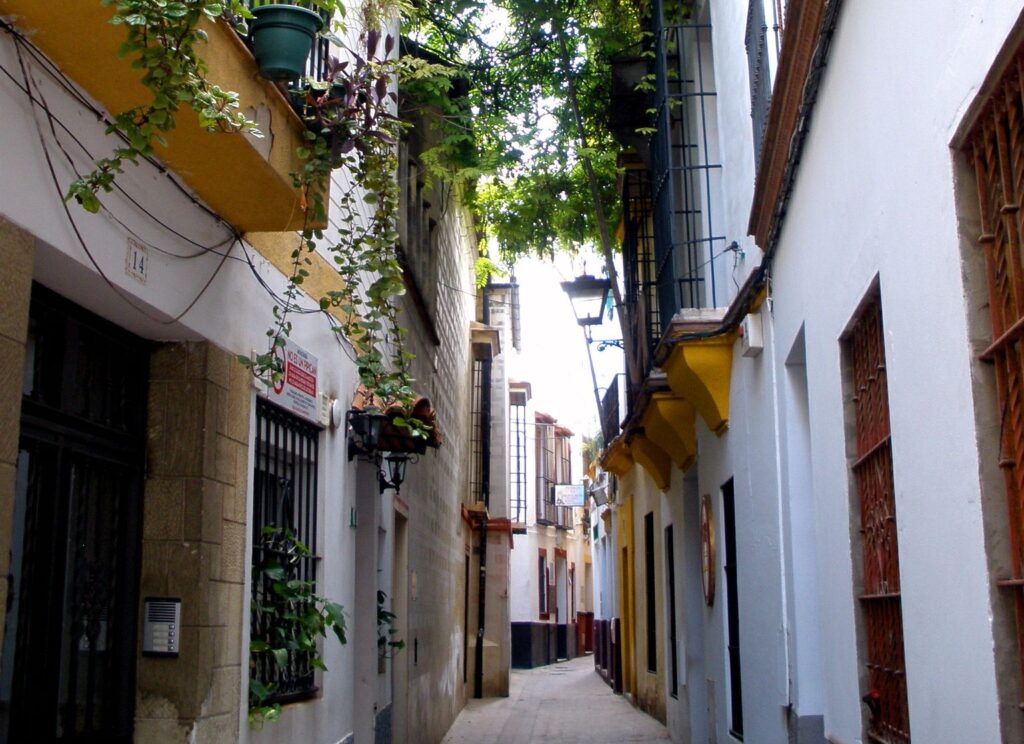
Another element that strongly influences the architecture of Seville is the heat. Seville is one of the hottest major cities in all of Europe and summer temperatures frequently cross well over 100 degrees Fahrenheit. (38 c) Seville is filled with many narrow streets which create shady cooler conditions for those walking outside. Seville also has a plethora of plants, gardens, and fountains which help keep the city cool.
Ancient Roman Architecture in Seville
The Ancient Romans took over Seville after the end of the Second Punic War. They built many Theatres, Aqueducts, and temples throughout the city – which was then known as Hispalis. Today very few traces of the Roman Age remain. There are a few sporadic Roman relics located throughout Seville’s historic core, but most of its ancient structures were torn down and repurposed in other buildings.
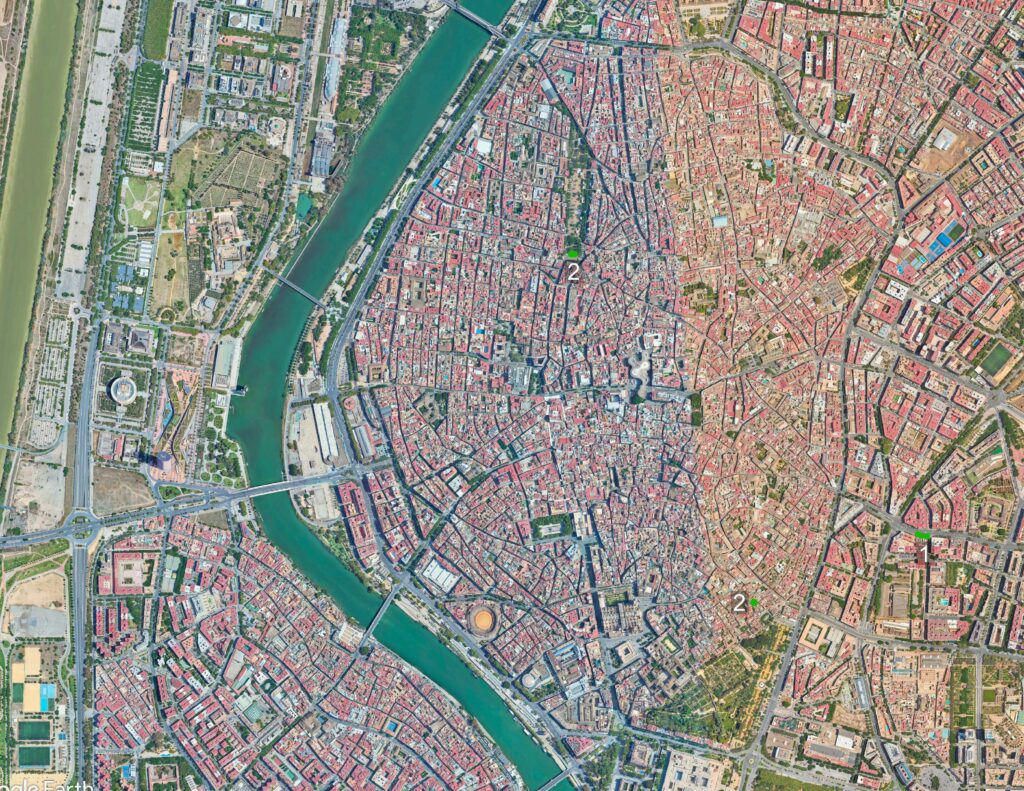
Map of Seville highlighting the most notable works of Ancient Roman Architecture within the city.
1. Caños de Carmona
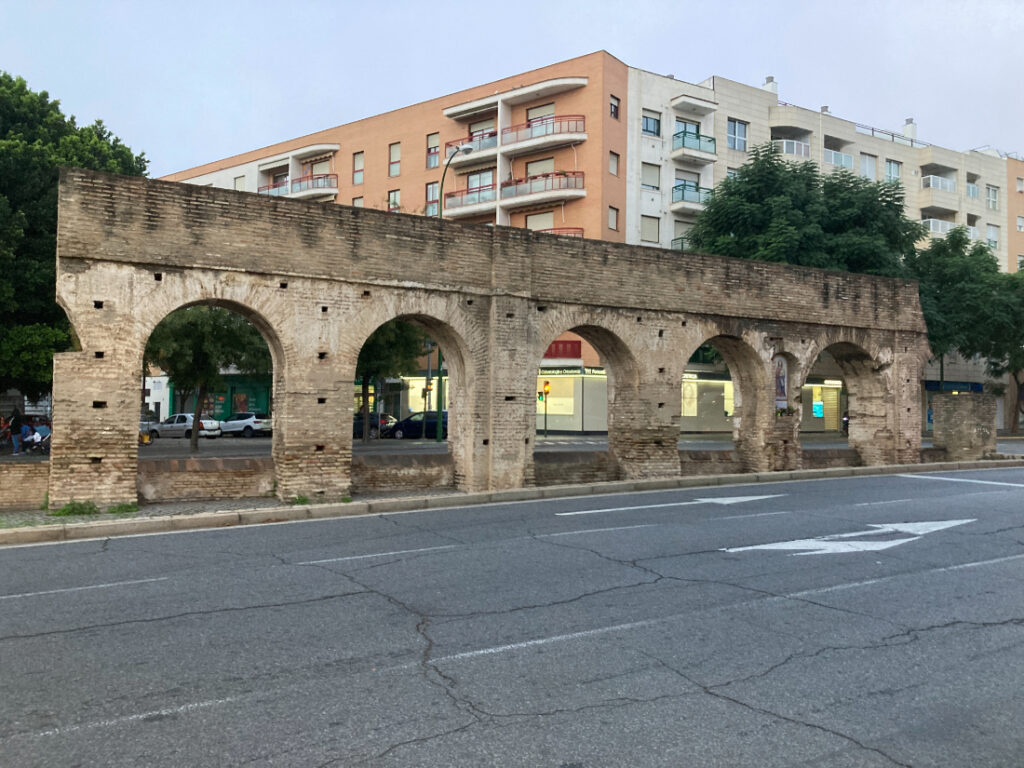
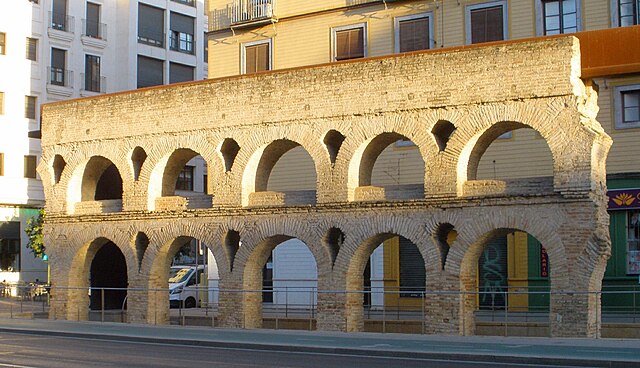
The Caños de Carmona was an Ancient Roman Aqueduct that once connected Seville and the nearby town of Carmona – a distance of over 10 miles. (17 kilometers) The remnants of this aqueduct are among the most impressive Roman ruins anywhere in Seville. In 1912 large portions of the aqueduct were demolished to make way for modern roads and buildings. But two sizable fragments remain both of which were reinforced to help protect them.
2. Seville’s Ancient Roman Columns
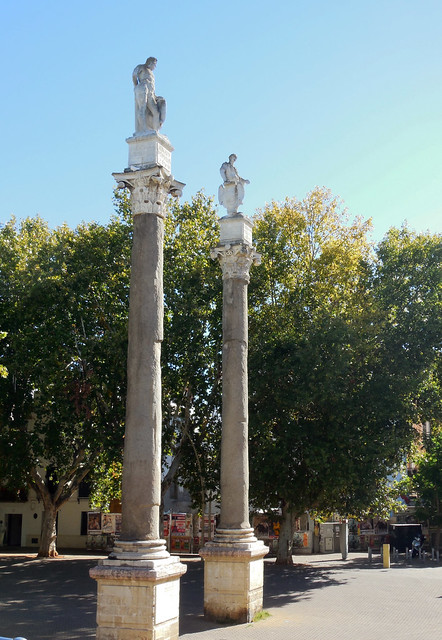
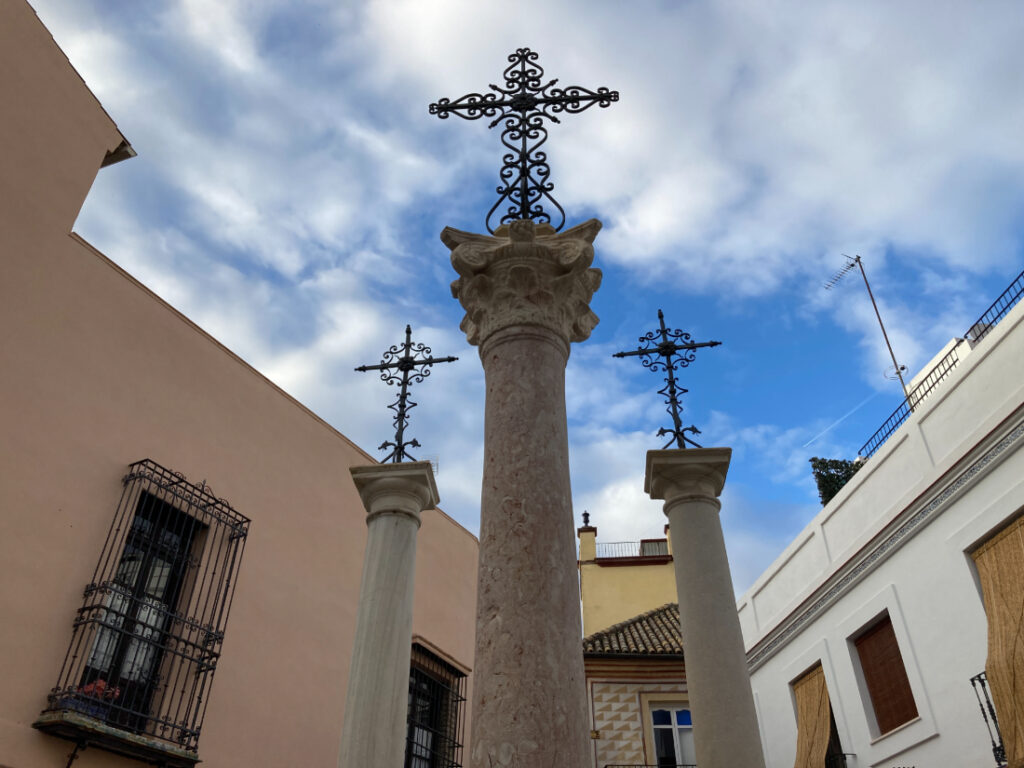
Seville is also home to several Ancient Roman Columns and monuments. Many of these have been salvaged from temples and other local buildings and repurposed within public squares. The left image above shows two Corinthian Columns topped with statues of Hercules. These are located within the Alameda de Hércules in modern-day Seville. The right image shows three ancient columns from different buildings in the surrounding area. Today they stand within the Plaza de las Cruces in Seville’s Santa Cruz Neighborhood.
Moorish Architecture in Seville
After the fall of the Roman Empire, Seville fell into the hands of the Visigoths, followed by the Moors. The Moors would establish a centuries-long presence in Southern Spain, creating a region known as Al-Andalus. Today there are countless examples of Moorish Architecture in Spain. Seville is home to several interesting examples of Moorish Architecture, many built by different rulers who controlled the city.
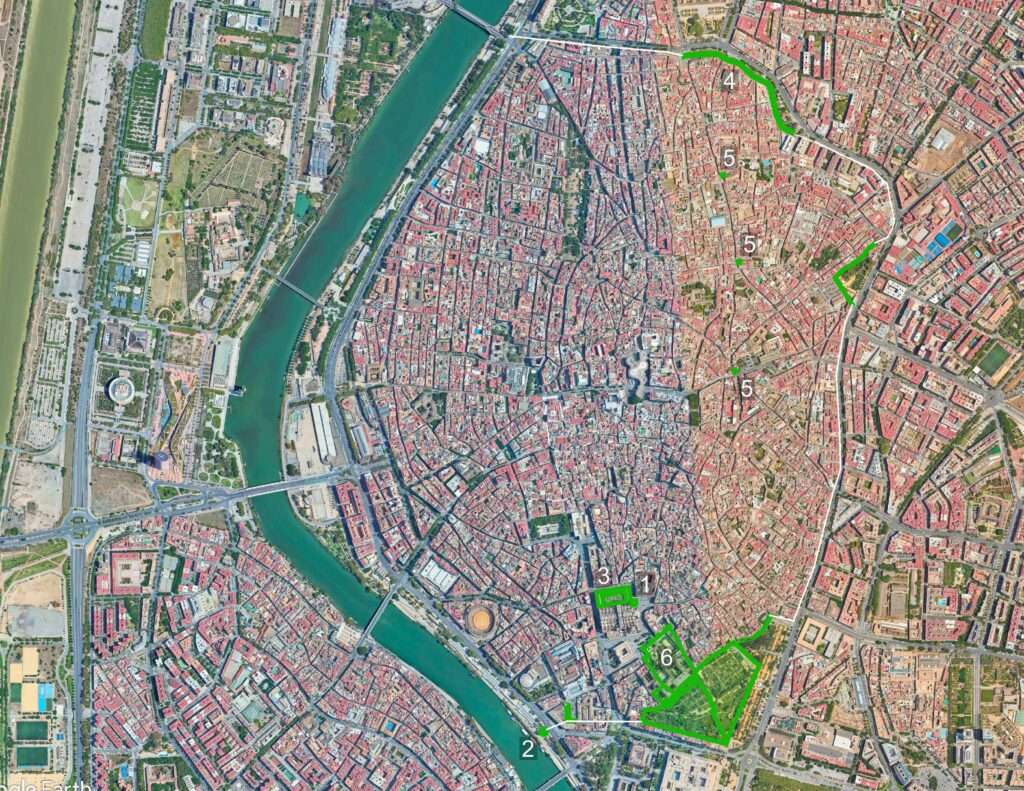
Map of Seville highlighting the most notable works of Moorish Architecture within the city.
The white line represents the outline of Seville’s Moorish fortification system.
1. La Giralda

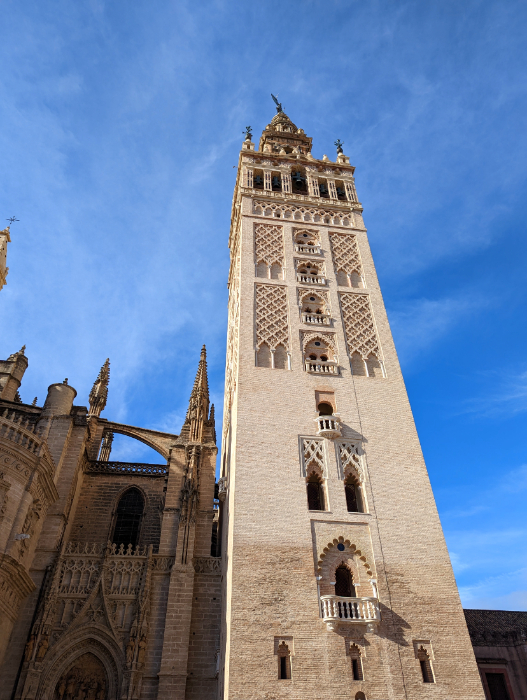
One of the various Moorish dynasties to control Al-Andalus was the mighty Almohad Caliphate. The Almohads controlled the city during the 12th century CE, and they commissioned the construction of a massive minaret beside the city’s largest mosque. The main portion of the Giralda was completed in 1198 and it contained several distinct elements from Moorish Architecture. The Giralda would continue to serve as Seville’s tallest minaret until it was converted to a bell tower after the Spanish took the city in 1248.
2. Torre del Oro


Another impressive work of Moorish Architecture in Seville is the Torre del Oro. Meaning “tower of gold” in English, the Torre del Toro was an impressive structure that marked the termination point of Seville’s city wall. The tower was constructed right on the banks of the Guadalquivir River and it helped protect both the city and its port. The tower served as a prison during the Middle Ages, and today it sits along a lengthy promenade on the river bank.
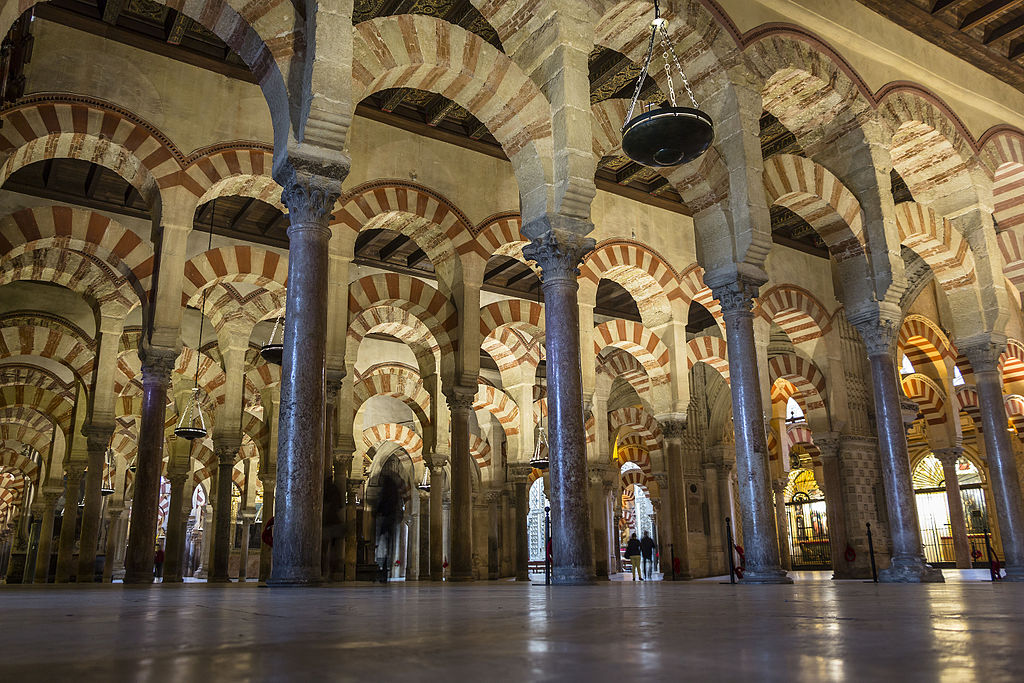
Interested in Islamic Architecture? Check out our article on the Moorish Architecture of Spain to learn more!
3. Courtyard of the Oranges
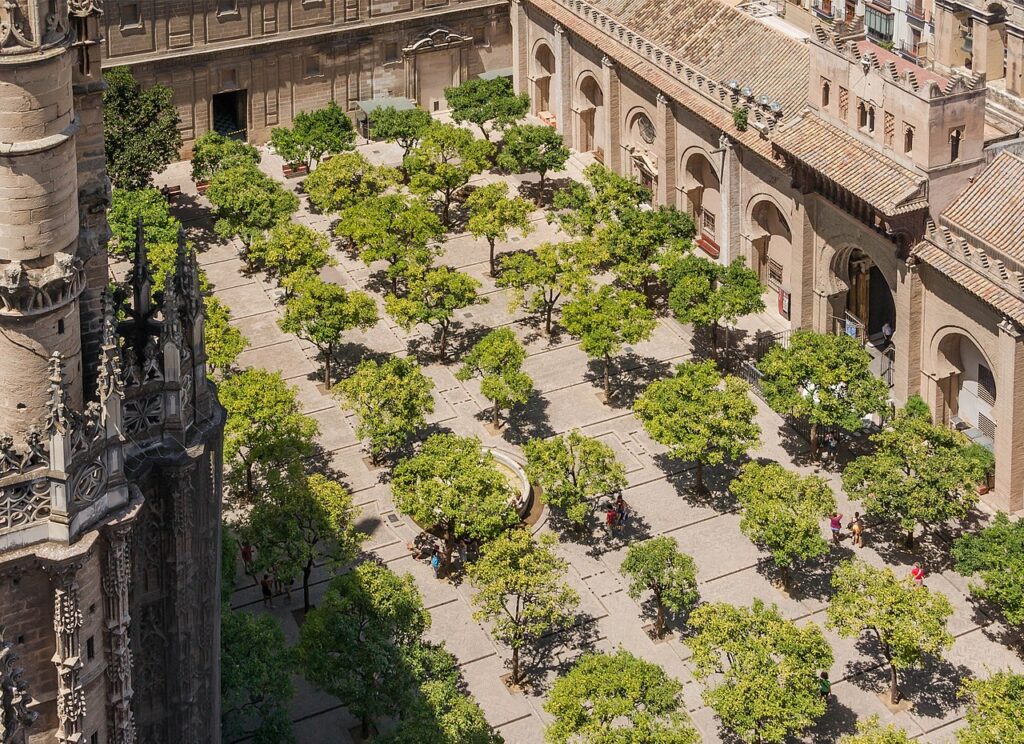
The Courtyard of the Oranges is a large relic from a former mosque that once stood in Seville. The majority of the Mosque was torn down to make way for Seville Cathedral, but the mosque’s former courtyard, or sahn, was repurposed as part of the Cathedral. Today the original Moorish portions of the structure are easily distinguishable, thanks to their horseshoe arches, which greatly contrast the pointed Gothic arches on the surrounding church. The courtyard has housed a collection of orange trees for centuries, a common form of vegetation found throughout Seville.
4. Remnants of Seville’s Walls

A ring of defensive walls once surrounded Seville. These walls had foundations dating back to the days of the Roman Empire. The Moors greatly expanded the walls during the five centuries they ruled the city. After the Siege and conquest of Seville by the Castilians, the walls continued to serve their purpose of protecting the city. Eventually, during the 19th century, large expanses of Seville’s fortifications were demolished to help the city expand. A few portions of the original Moorish wall remain to this day, mostly around the Grand Alcazar of Seville, and also on the northern edge of the city center by the Basilica Macarena.
5. Minarets of Seville
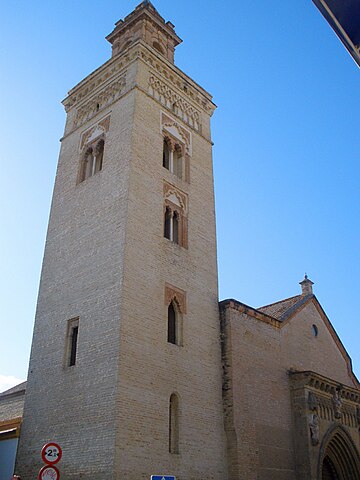

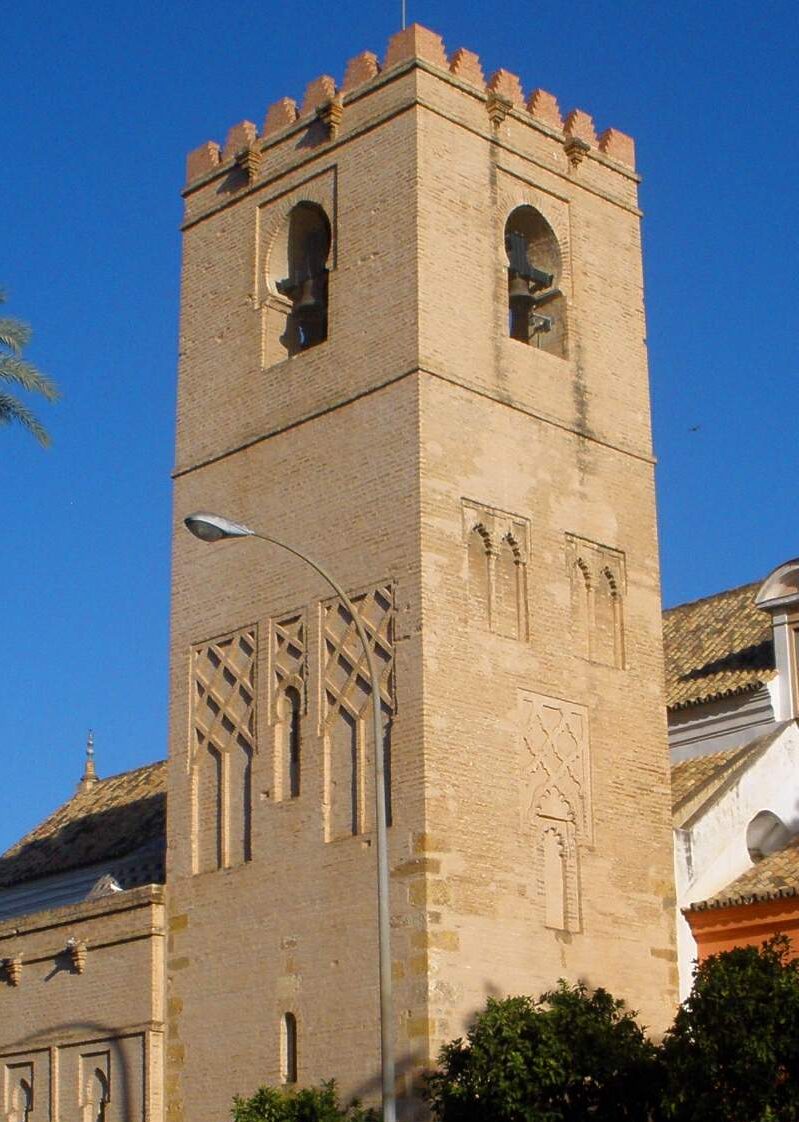
(left) Church of San Marcos (center) Church of Santa Marina (right) Church of Santa Catalina
The Moors constructed hundreds of Mosques throughout Al Andalus. These mosques all followed a similar format, many of them having rectangular minarets that date from the Almohad period. There are several Minarets throughout Seville that now function as belltowers for local churches. The most famous example of this is of course the Giralda, but similar structures can be found at the churches of San Marcos, Santa Marina. and Santa Catalina.
6. Alcazar de Sevilla

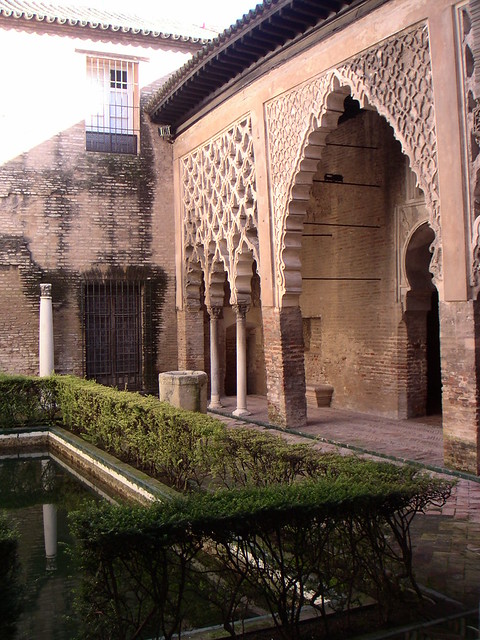
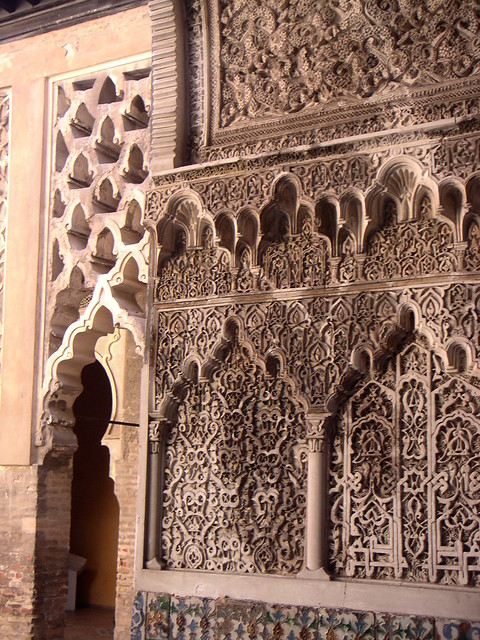
The Real Alcázar de Sevilla, was originally a fortress located in the southern portion of Seville’s fortification system. During the Spanish Golden Age, the Alcazar was completely redone into a Mudejar-style palace. However, amongst the newer gardens and rooms, there are still traces of the original Moorish building The images above show a few fragments of the Alcazar of Seville from before the Castilian conquest of 1248. These portions of the building contain many typical elements from Moorish Architecture including horseshoe arches and intricate geometric detailing.
Gothic Architecture in Seville
The Kingdom of Castile conquered Seville during the height of the Reconquista Movement. After this, they immediately got to work tearing down the city’s mosques and constructing Gothic Churches in their place. Similar transformations were occurring all over Al Andalus as Spanish forces continued to push further south. One of the most iconic examples of Gothic Architecture in Seville is of course Seville Cathedral – the largest Gothic Church on earth. In addition to the cathedral, there are several other impressive Gothic buildings throughout Seville mostly dating from the 13th to 15th centuries.
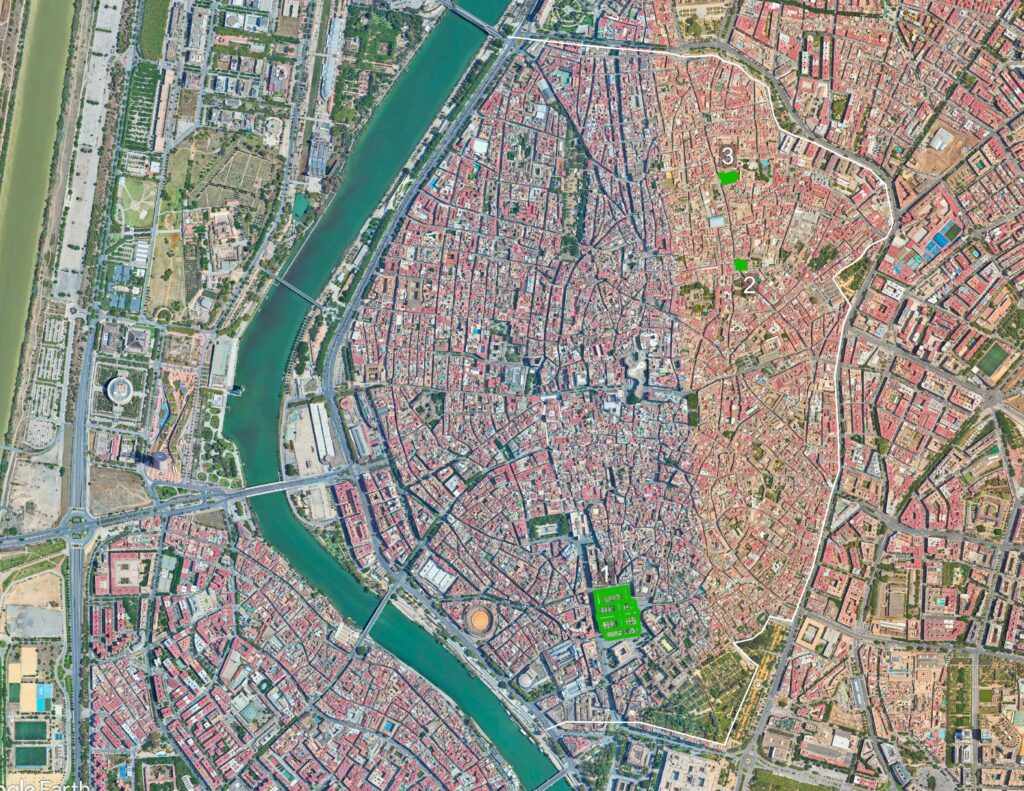
Map of Seville highlighting the most notable works of Gothic Architecture within the city.
The outlines of the Medieval fortifications are shown with a white line.
1. Cathedral of Seville
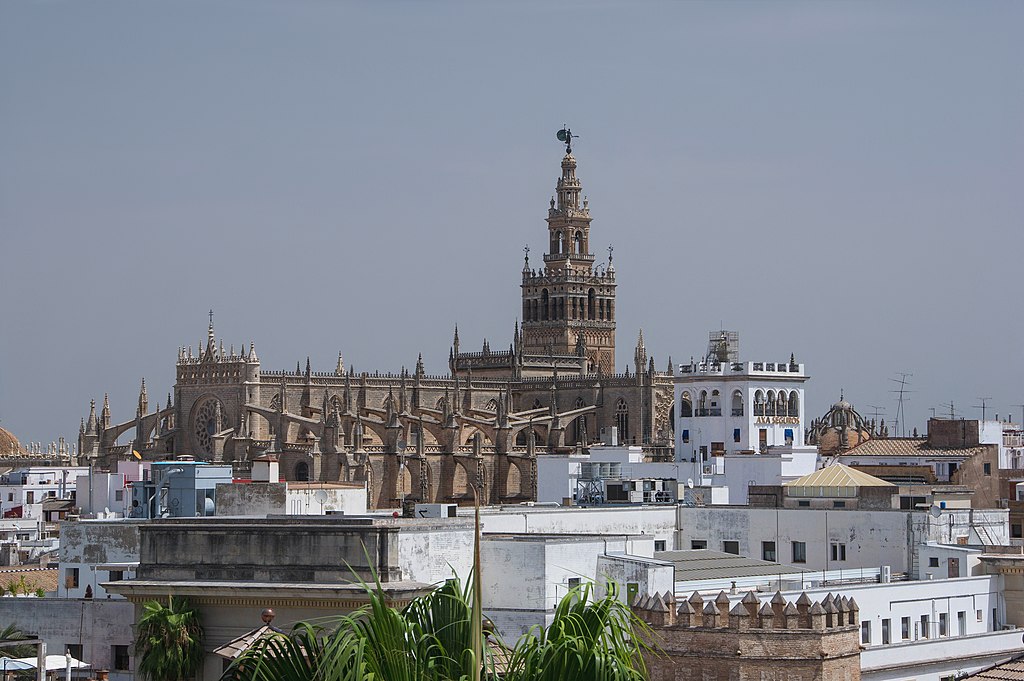
Seville Cathedral is by far the greatest example of Gothic Architecture in the entire city. It is the world’s largest Gothic Cathedral and also one of the top five largest churches on earth by volume. The church was begun shortly after the Castilian Conquest of Seville in 1248 and was completed by the early 1500s. Seville Cathedral is part of a UNESCO World Heritage Site that also includes other notable monuments in the city.
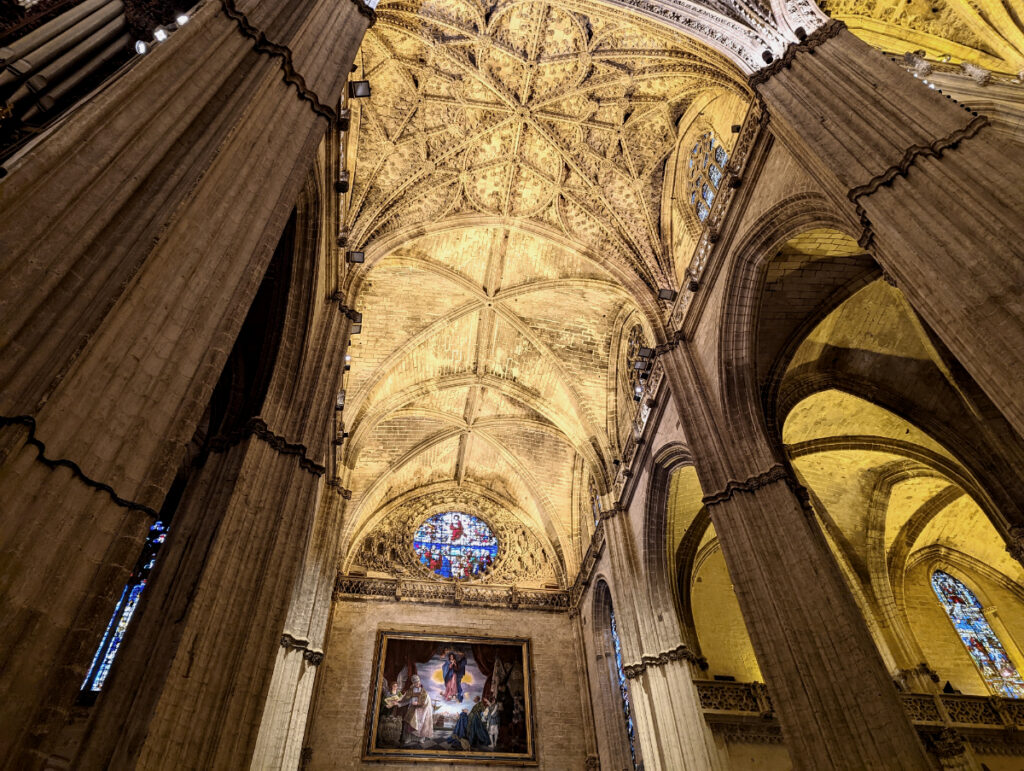
The interior of Seville Cathedral is known for its towering Gothic Vaulted Ceilings. They are some of the tallest in Europe at 138 feet (42 m) and are intricately decorated with lots of Gothic Tracery. The church also has a large collection of Stained Glass, one of the most unifying elements in Gothic Architecture. Seville Cathedral also houses the tomb of Christopher Columbus, a revered figure in Seville’s history.


Seville Cathedral is also famed for its eclectic blend of architectural styles. The church’s bell tower, the Giralda is an incredible example of Moorish Architecture, along with the Courtyard of the Oranges, which serves as the church’s cloister. Seville Cathedral also contains an assortment of chapels and other additions that were built later on in the Renaissance and Baroque Ages. Together, all of these various components make Seville Cathedral one of the most interesting buildings in Europe, and visitors often spend multiple hours exploring all of its unique spaces.

Gothic was the dominant architectural style in Europe during the early Middle Ages. Check out our article on the Top 25 Examples of Gothic Architecture to learn more!
2. Church of San Marcos

The Church of San Marcos is another impressive example of Gothic Architecture in central Seville. It’s known for its distinct bell tower, which like the Giralda, is a repurposed minaret dating from the days of the Moors. The church has a very distinct portal, which is marked by a massive Gothic arch. Gothic arches are known for their distinct point, which contrast the round and horseshoe arches that were common in Seville before the Gothic Age.
3. Iglesia di San Marina

The Church of San Marina bears a striking resemblance to the Church of San Marcos. Both churches were built at the same time and they both blend Gothic and Moorish building components. The Church of San Marina is famous for its bell tower, which was constructed by the Almohad Caliphate during their rule in Seville. There are dozens of churches just like this one within Seville, and other nearby cities such as Cordoba, Granada, and Jerez de la Frontera.
Renaissance, Baroque, and Mudejar Architecture in Seville
Like many other cities and countries, there was a clear time when Seville had a Golden Age of growth and prosperity. After the discovery of the New World in 1492, Seville became Spain’s major trading port. The city had a well-protected harbor on the Guadalquivir River, and it was an ideal spot for merchant ships to unload their precious cargo. Seville, and its people, grew fabulously wealthy from all of this trade, and the city saw a building boom that lasted from the 16th to the 18th century.
Seville contains a vast array of both Renaissance and Baroque Architecture – Europe’s dominant building styles from this period. Thanks to the city’s historic Moorish influence, Seville also contains a variety of Mudejar-style buildings, which are unique to this part of the Iberian Peninsula.

Map of Seville highlighting the most notable works of Renaissance, Baroque, and Mudejar Architecture within the city.
1. Alcázar de Sevilla
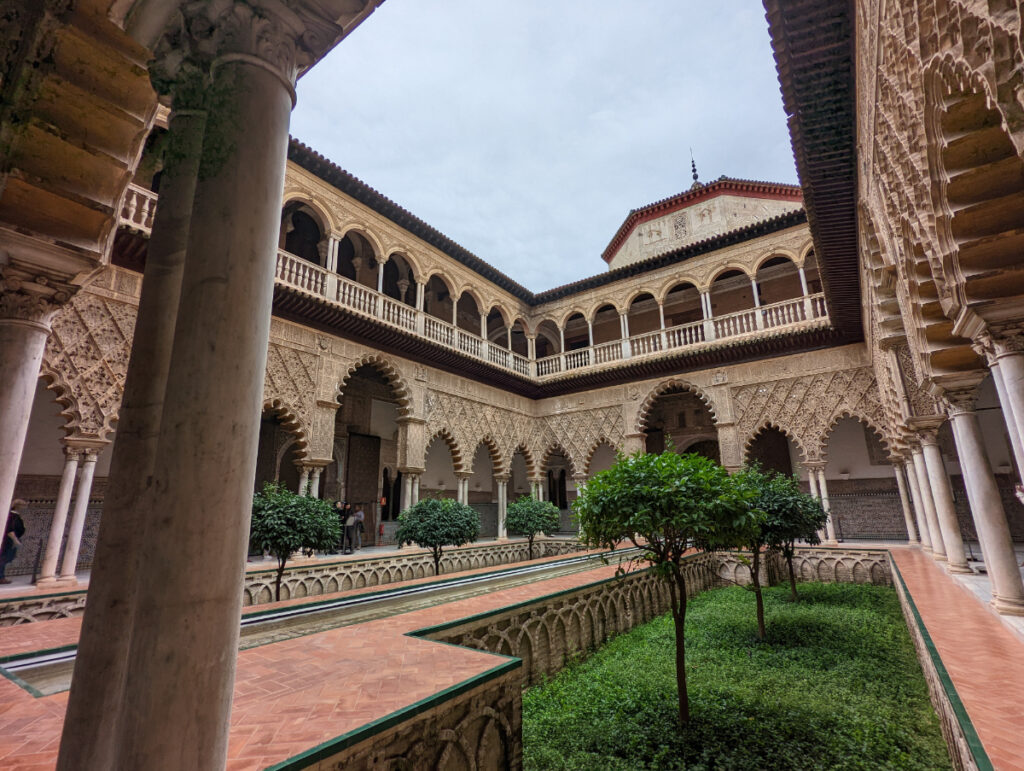
The Royal Alcázar of Seville was originally a Moorish fortress located in the southern portion of Seville’s fortified walls. The building was completely renovated under Spanish rule, and it was converted into one of Spain’s most well-known examples of Mudejar Architecture. The Alcázar contains a variety of ceremonial rooms, banqueting halls, courtyards, and living quarters. It has a blend of traditional Islamic Design Elements in addition to European building components. You can see a great example of this in the image above – the lower level of arches are Islamic Style with lots of geometric details and intricately carved reliefs – while the upper arches are Renaissance style, with a focus on balance, symmetry, and proportion.
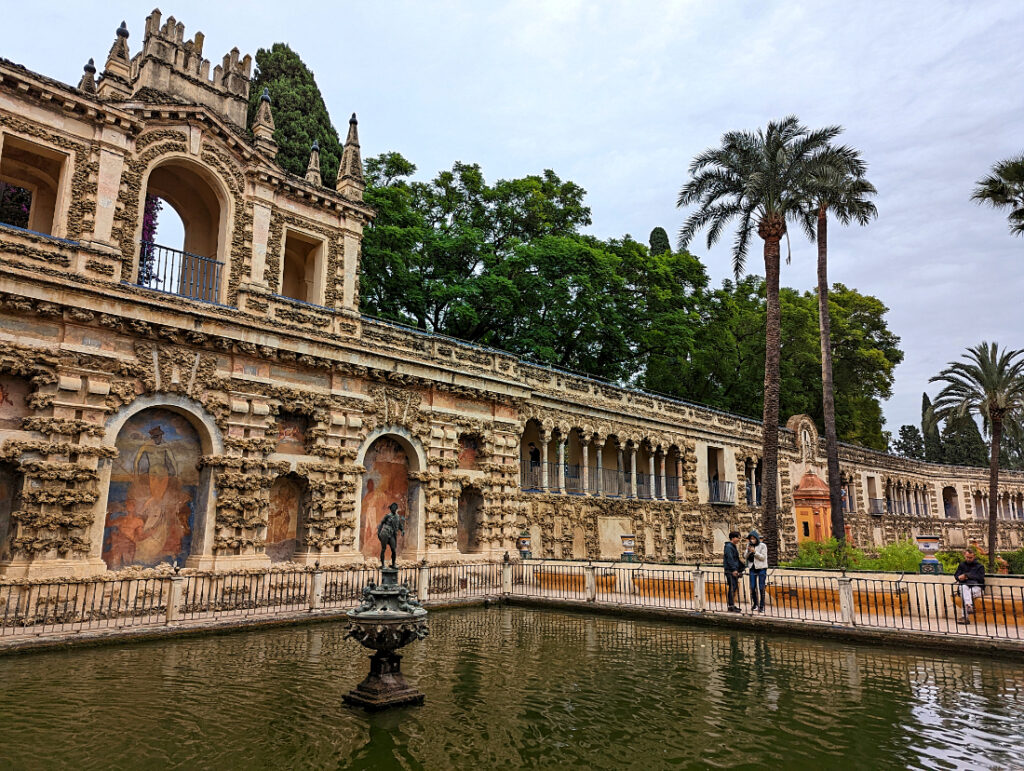
The Royal Alcázar of Seville is perhaps most known for its elaborate gardens. These were once a favorite spot for the Spanish Royal Family, and today they are open to the public and one of the most visited attractions in all of Seville. The Royal Alcázar Gardens are also famous thanks to their appearance in HBO’s Game of Thrones. The entire Royal Alcázar complex is part of a UNESCO World Heritage Site along with Seville Cathedral and the General Archive of the Indies.
2. Palacio de San Telmo
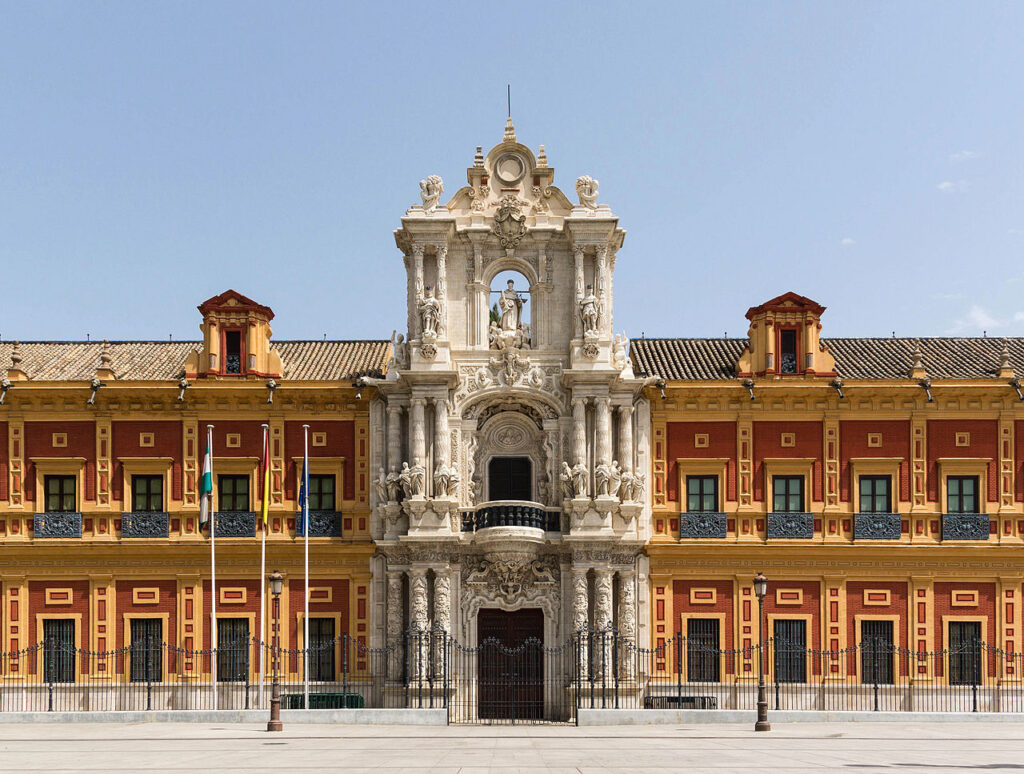
The Palace of San Telmo is a massive building, located in central Seville not far from the banks of the Guadalquivir River. It has a rectangular footprint with a front facade spanning 450 feet (137 m), and sides measuring 200 feet (61 m). Construction began on the palace in 1682 and would take over 70 years. The Palace of San Telmo is known for the elaborately detailed stone around its main entrance. The entire building evokes a sense of grandeur and splendor, which was a key idea behind Baroque Architecture.
3. Archbishop’s Palace
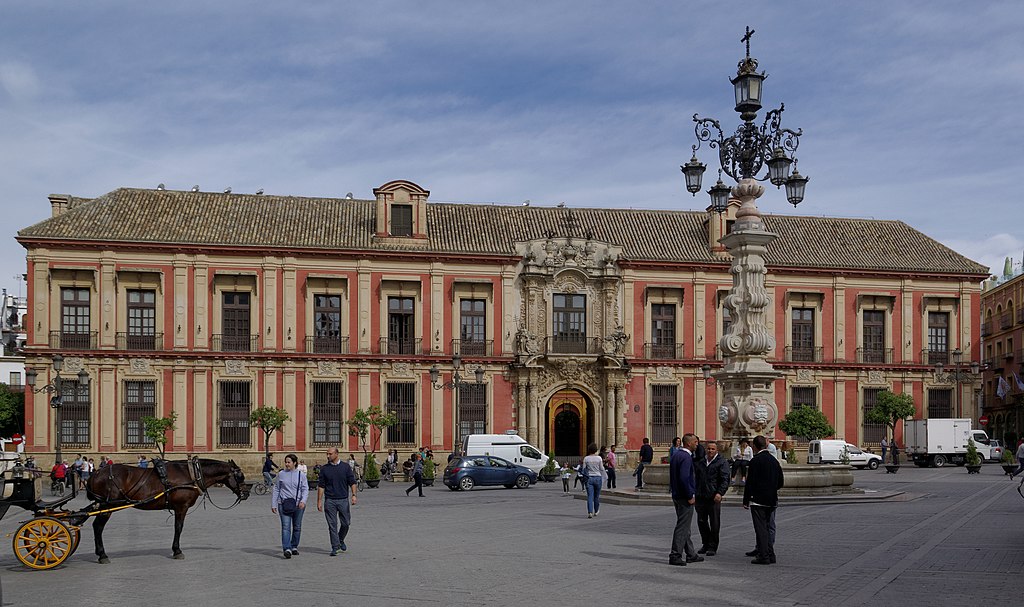
Located just across from Seville Cathedral, the Archbishop’s Palace is another great example of Baroque Architecture in Seville. The palace has origins dating back to the Gothic Age, but Most of what we see today dates to a large renovation that occurred in the early 1700s. Like the Palace of San Telmo, the Archbishop’s Palace contains many of the key elements found in Baroque designs. The entire facade is decorated with bright colors, and it also contains lots of intricate and ornate details.
4. Royal Tabacco Factory
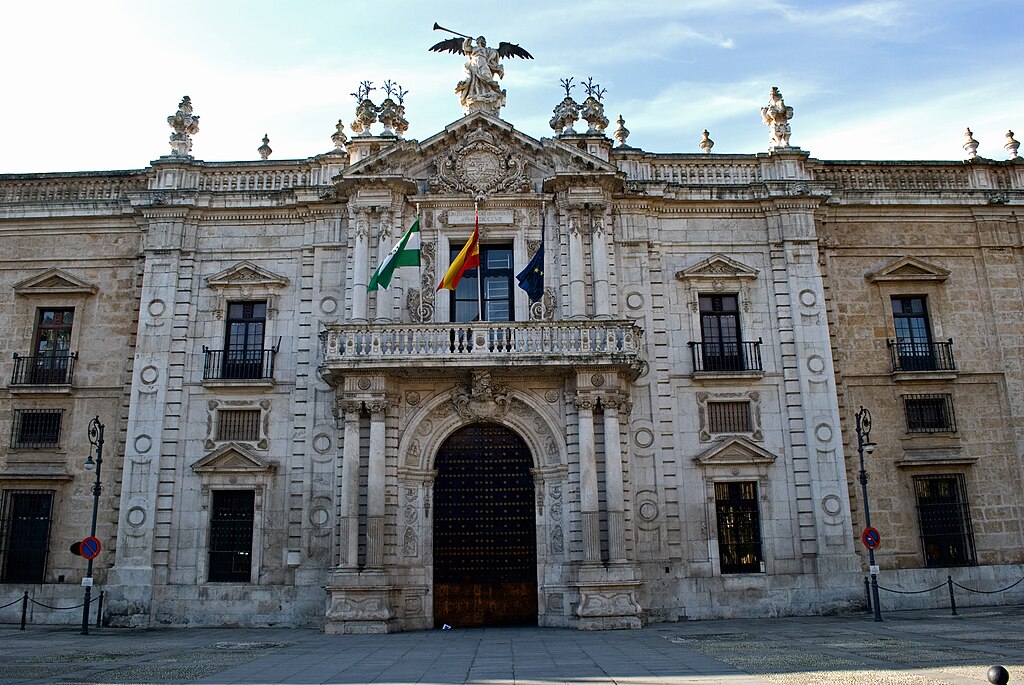
The Royal Tobacco Factory is another enormous building dating from the Golden Age of Seville’s architecture. It was once one of the largest buildings in all of Spain with a footprint of 580 feet by 480 feet (176 x 146 m). The Royal Tobacco Factory was originally built as an industrial building, for the importing, drying, and production of tobacco products. Construction began on the building in 1728 and it has been owned by the University of Seville since the mid-1900s.
Like Architecture of Cities? Sign up for our mailing list to get updates on our latest articles and other information related to Architectural History.
5. Seville City Hall

Seville City Hall was constructed during the Renaissance Age, in a form of architecture known as Plateresque. The main facade in the image above dates to the early 1500s. The opposite side of Seville City Hall was expanded and has a much less decorative Neoclassical Facade from the 19th century. The Plateresque side of the building is known for its intricate stone detailing. The facade is a great example of the grand and opulent buildings that were being constructed throughout Seville’s Golden Age.
6. Church of San Salvador

The Church of San Salvador is one of the greatest examples of Baroque Architecture in Seville. It has many of the key elements in the Baroque style including a brightly colored facade, outfitted with lots of intricate details and complex geometries. The church was constructed in the late 17th century and it is one of the largest churches in all of Seville. Like countless other churches throughout this part of the world, the Church of San Salvador stands on the foundation of a Mosque that was constructed by the Umayyad Caliphate, who took over Seville in 712 CE.
7. General Archive of the Indies

Although not as large as some of the other buildings on this list, the General Archive of the Indies is an important building in Seville thanks to its extraordinary historical significance. The Archive is home to countless books, records, manuscripts, and other documents relating to the Spanish Empire and the Discovery of the New World. The documents in the archive also contain vital information on not only Spanish History but also the history of the Americas and civilizations like the Aztecs and Inca. The building and its entire collection are designated as part of Seville’s UNESCO World Heritage Site.
8. Andalusian Parliament Building
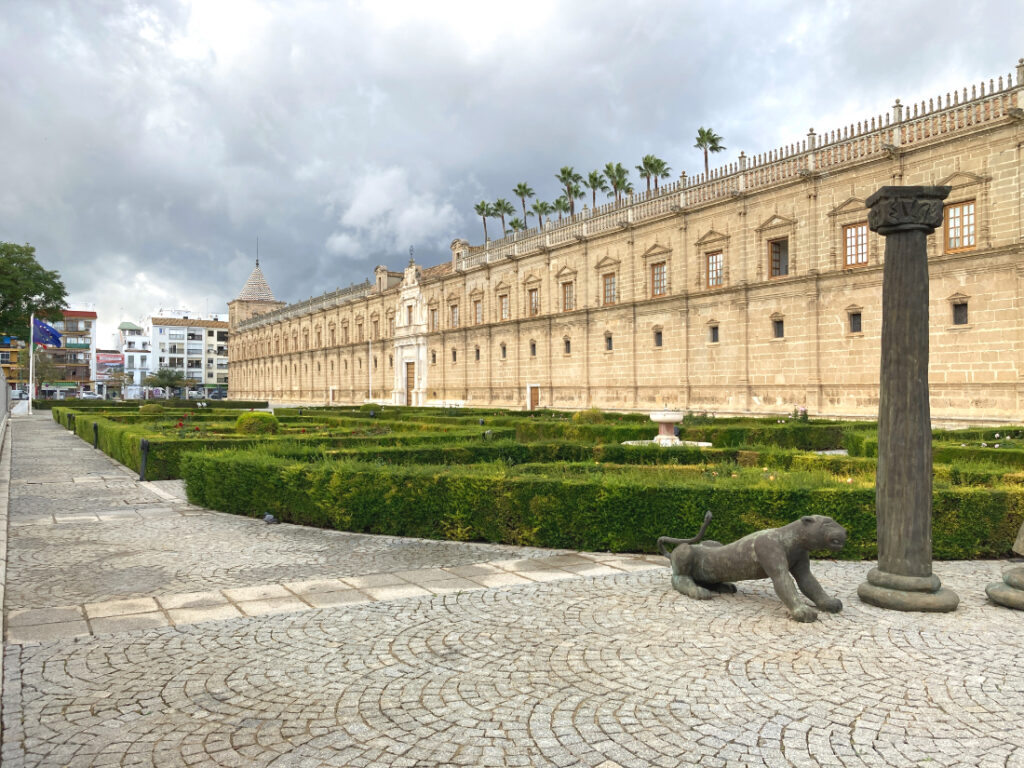
The Hospital de las Cinco Llagas is an impressive work of Renaissance Architecture in Seville. The building now houses the Andalusian Parliament, and it is one of the many large buildings constructed during the Golden Age of Seville and the Spanish Empire. The building was constructed in the mid-1500s, at a time when the Renaissance movement was starting to emerge from Italy. The exterior embodies many key Renaissance ideologies, like symmetry, balance, hierarchy, and proportion.
9. La Giralda (top)
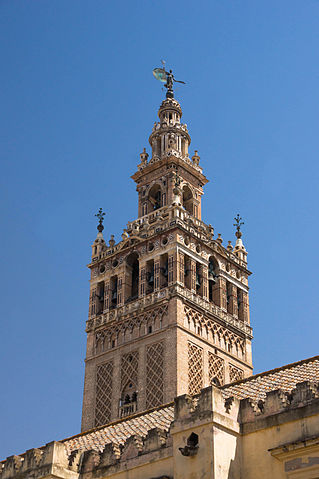
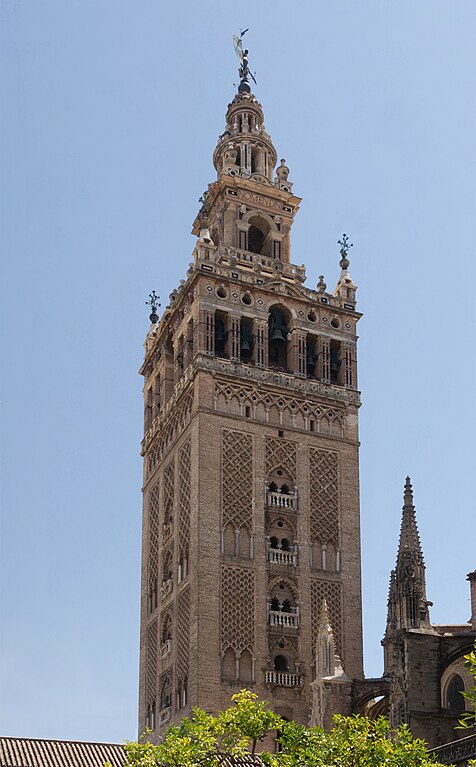
The Giralda is one of Seville’s most iconic monuments, and it’s an amazing example of the various cultures that have ruled over the city. The base of the Giralda contains many large stones from the Roman period, some of which even bear Latin inscriptions. Above that is a tall tower that was constructed as a minaret by the Moors. And, atop the minaret, the Spanish constructed a large Baroque “cap” that houses bells. The Baroque portion of the Giralda dates from the mid-1500s and has been replicated in other towers in Spain and the rest of the world.
10. Church of San Luis of France

The Church of San Luis of France is a Baroque Church that was completed in 1731. It resembles many other examples of Baroque Architecture in Seville. The church has an incredible front facade that faces a street also named “San Luis”. The interior of the building is equally as impressive as the exterior, and it is outfitted with many Baroque embellishments like gold trim and intricate carvings.
11. Seville Cathedral Chapterhouse

The Chapter House is one of the several unique side chapels and additions added to Seville Cathedral. The main room of the Catheral’s Chapter House dates to the 1590s. The space is outfitted with lots of Renaissance-style sculptures and other artwork. The room is also topped with a large elliptical dome, which was a unique feature found in Late Renaissance Architecture. Although earlier structures made use of mostly circular domes, elliptical domes were a new element that began during the transition to the Baroque Period.
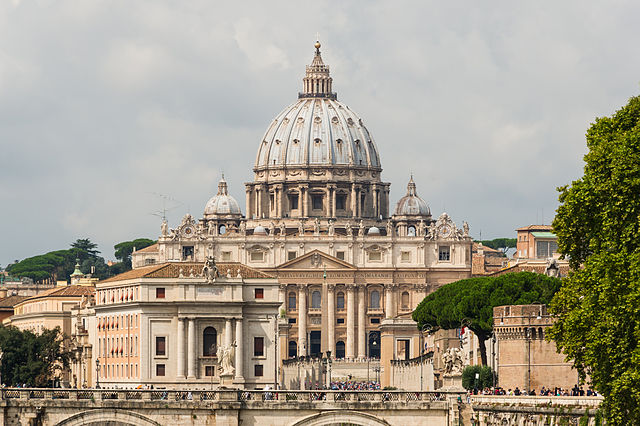
The Renaissance Style began in Italy and eventually spread to the rest of Europe. Check out our article on Renaissance Architecture to learn more!
12. Casa de Pilatos

Casa de Pilatos was a large private residence built by a wealthy noble family in Seville. Construction began on the building in the late 15th century, and it was inspired by other Renaissance structures being built throughout Western Europe at that time. The Casa de Pilatos has a unique Mudejar twist to it though. In addition to elements from Renaissance Architecture, the building contains other Islamic Mudejar characteristics such as Moorish-inspired detailing and Spanish Tiles.
13. Museum of Fine Arts of Seville
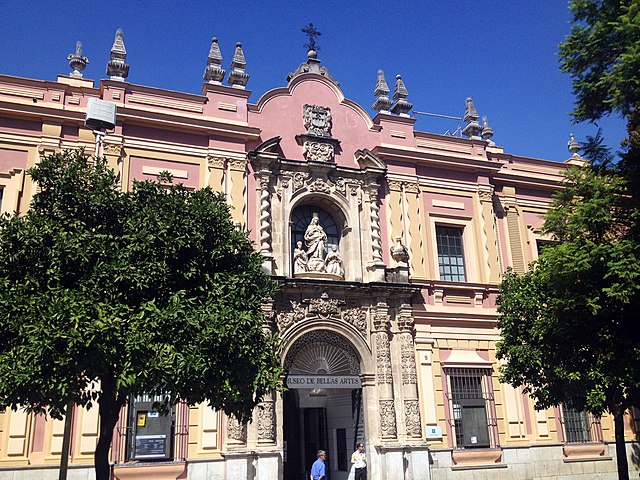
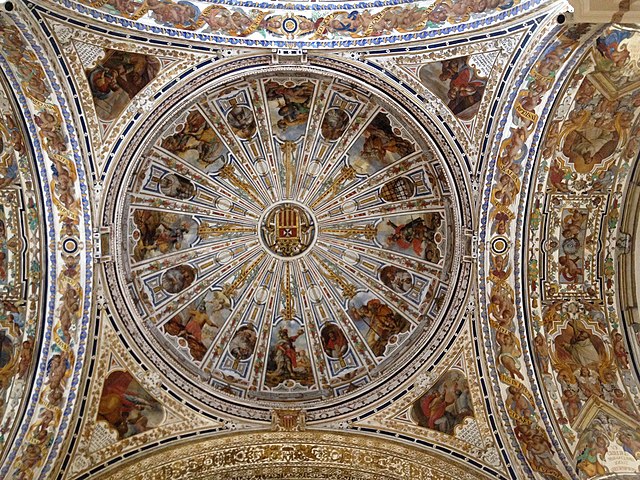
The Museum of Fine Arts of Seville is one of the most renowned art institutions in Andalusia. It is housed in a building from the late 16th century that originally served as a convent. The museum is another typical example of Sevillian Baroque Architecture and it has similar characteristics to other buildings on this list. The Museum of Fine Arts contains a wide assortment of artwork, with a great focus on Spanish art from the Medieval Period up until the 19th Century.
14. Seville Cathedral Sacristy

Seville Cathedral also contains an incredible sacristy that was completed in the 16th century. The sacristy contains an eclectic blend of Renaissance and Baroque design elements. The space is perfectly symmetrical, with a circular dome atop four arches. The interior is richly decorated and features elements from Classical Architecture like Corinthian Columns, molding, and friezes. There is also a plethora of carved figures spread throughout other sculptures including sea shells and plants.
15. Plaza de Toros de la Real Maestranza
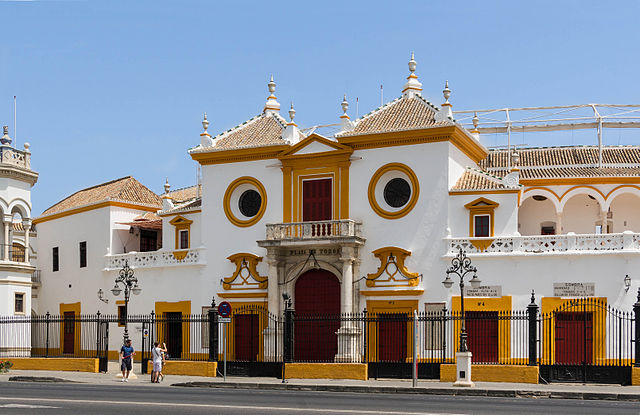

Like many other cities in Spain, Seville contains a bull ring or Plaza de Toros. Bullfighting has been an important part of Spanish culture for centuries, and the sport is particularly popular in Southern Spain and Andalusia. The Plaza de Toros de la Real Maestranza is a great example of Baroque Architecture and it was completed in the late 1700s. The ring is still a popular venue for bullfights in modern times, and it also hosts a renowned bullfighting festival every year.
Revival Architecture in Seville
During the mid-1700s trade in Seville began to decline dramatically. Spain began doing most of its importing through the Atlantic harbor at Cádiz and there was also a general decline within the Spanish Empire. Seville saw an end to its Golden Age, and the city entered a period of stagnation. Eventually, the Industrial Revolution spurred a lot of growth and the city’s population expanded. Seville demolished large portions of its fortified walls at this time and also constructed many great examples of Revival-Style Architecture.
Seville also contains a lot of structures that were built for the Ibero-American Exposition of 1929. This was one of the last great “World’s Fairs” and it drew huge crowds to Seville. The exposition included pavilions representing nations like Argentina, Mexico, Cuba, Colombia, Brazil, and the United States.
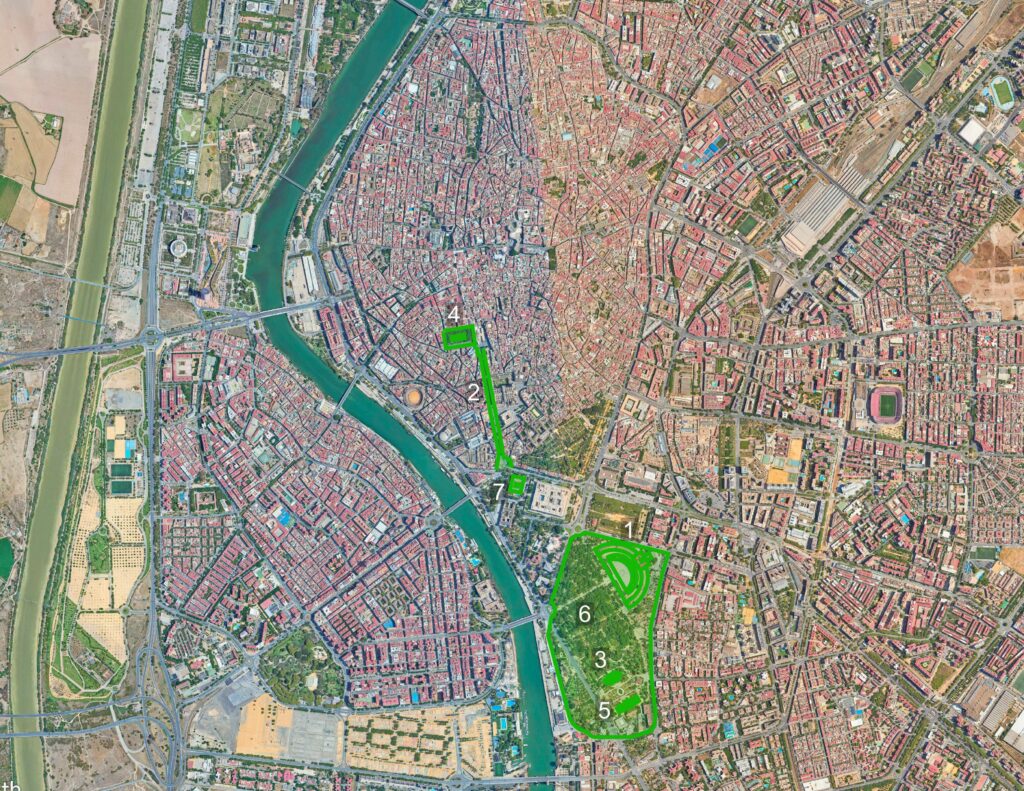
Map of Seville highlighting important works of Revival Style Architecture within the city.
1. Plaza de España
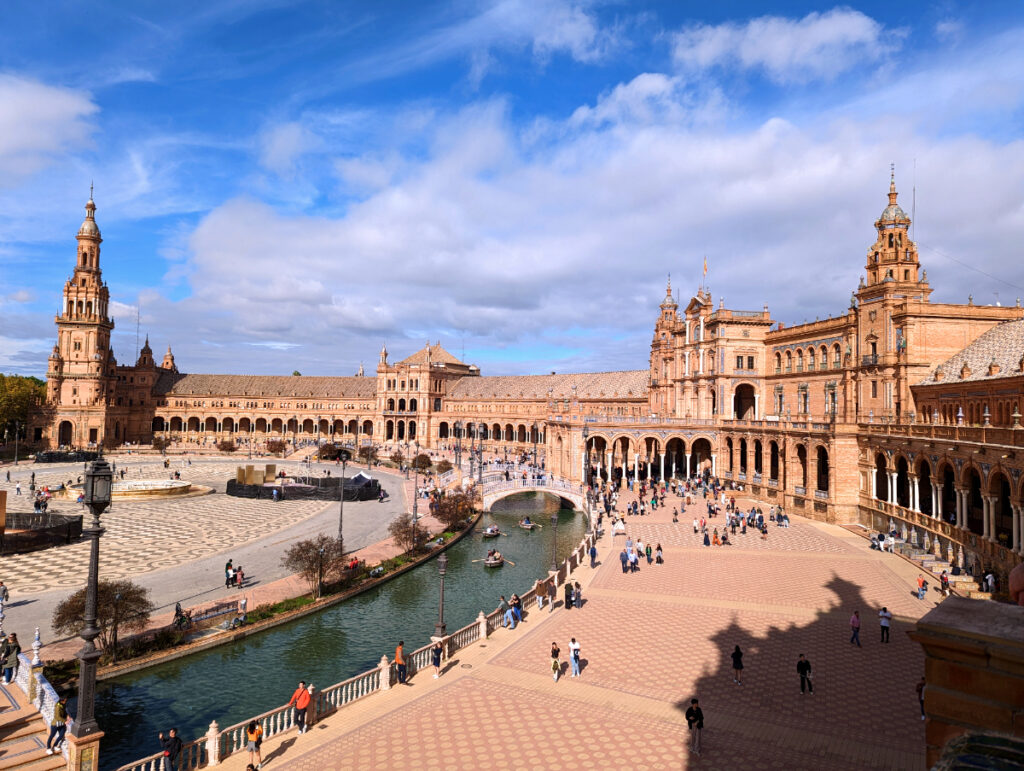
The centerpiece of the Ibero-American Exposition of 1929 was Plaza de España. The plaza consists of an open area surrounded by a manmade canal and a large semi-circular building. The building contains a unique blend of Revival and Mudejar Architecture that is emblematic of the region of Andalusia. Construction began on the Plaza de España just one year before the exposition, and it has grown to become one of Seville’s most well-known and photogenic landmarks.


The Plaza de España is renowned for its decorative features that showcase Spanish Culture. In the left image above you can see an incredible mosaic of Spanish Tiles. The tiles depict the nearby city of Zaragoza, and there are dozens of similar works of art throughout the entire building. Plaza de España is regarded as one of the most vibrant Public Plazas in Spain and it’s just one of many incredible buildings from this period in Seville’s history.
2. Avenida de la Constitución


The Avenida de la Constitución is one of the busiest streets within Seville’s historic center. It connects several notable landmarks including Seville Cathedral and Plaza Nueva. The avenue was largely built up during the late 19th and early 20th centuries. It contains a host of impressive Revival-style buildings, most of which were financed by wealthy Sevillian Families. The left image above shows one of the street’s most impressive structures: El Edificio de La Adriática. The Mudejar-style building was completed in 1922 and contains many important influences from the Moorish Architecture that once thrived in Spain.
3. Museum of Arts and Popular Customs of Seville

The Museum of Arts and Popular Customs of Seville is another work of Mudejar Architecture constructed for the Ibero-American Exposition of 1929. It’s located within the expansive Parque de María Luisa, on the southern edges of Seville’s historic center. The building contains many typical elements in the Mudejar Style, including Islamic-inspired tiles, geometries, and calligraphy. Today the building is used as an additional branch of Seville’s Museum of Fine Arts, and it houses paintings, sculptures, and a wide variety of Andalusian Ceramics.
4. Plaza Nueva

Plaza Nueva is a large public space in central Seville that was retrofitted in the 1800s. The plaza is enclosed by a series of 19th-century buildings, along with Seville City Hall, located on the eastern edge. The Plaza’s focal point is a massive equestrian statue of Ferdinand III of Castile. Ferdinand was the infamous monarch who retook Seville from the Moors in 1248. Today Ferdinand III is still an important figure in Seville’s history, and his statue has stood within Plaza Nueva ever since the square was revamped in 1856.
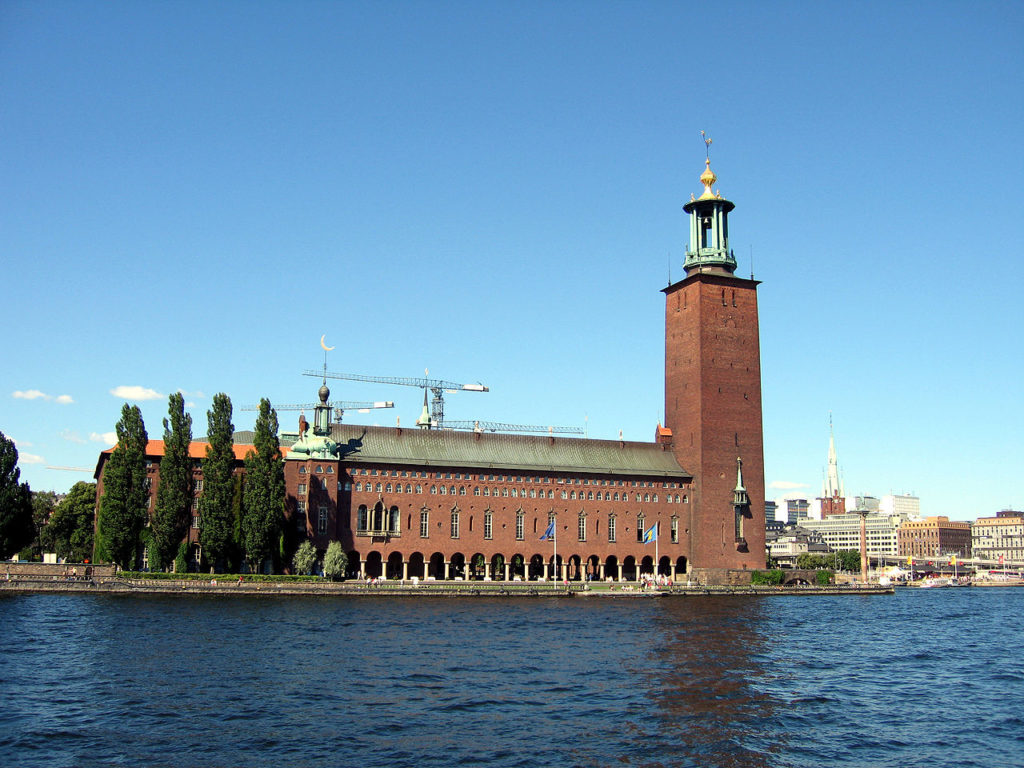
Interested in Revival Architecture? Check out our article on the Architecture of Stockholm to see more great examples of Revival Style Buildings.
5. Seville Archeological Museum
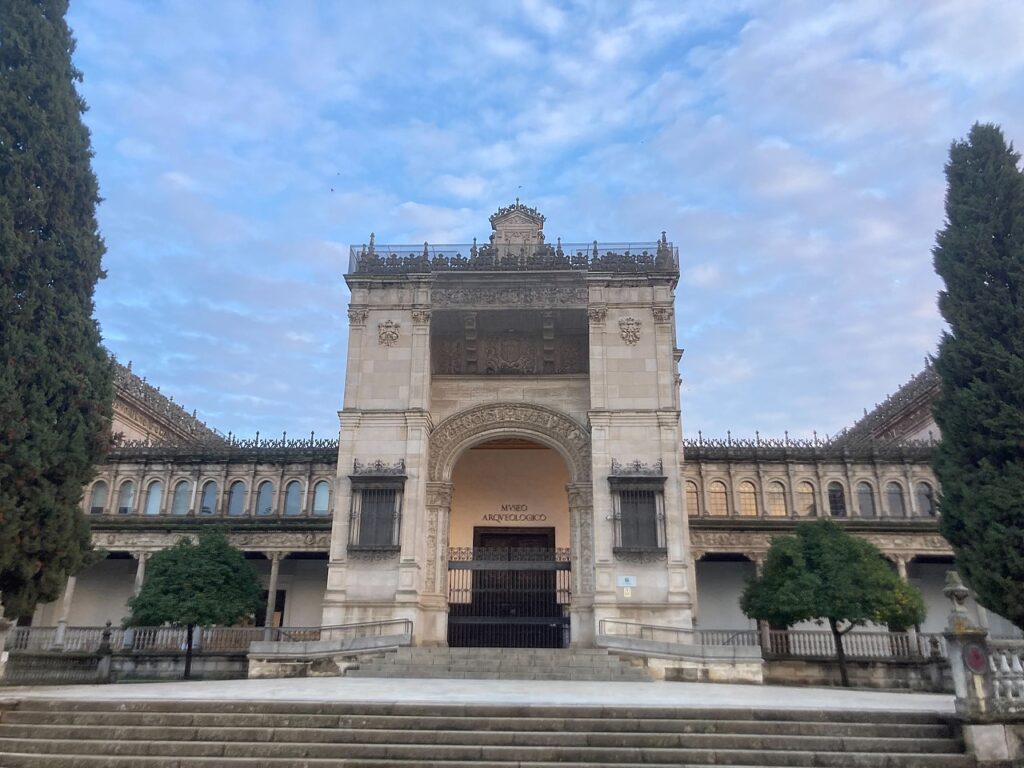
The Archeological Museum of Seville is another impressive building dating from the Ibero-American Exposition. The museum occupied the space shortly after the end of the exposition, and today it is home to some of Andalusia’s most precious artifacts. The museum contains an assortment of Ancient Phoenician relics, found at a nearby burial shrine. There are also lots of statues, coins, and other objects excavated in the nearby Roman town of Italica.
6. Parque de María Luisa
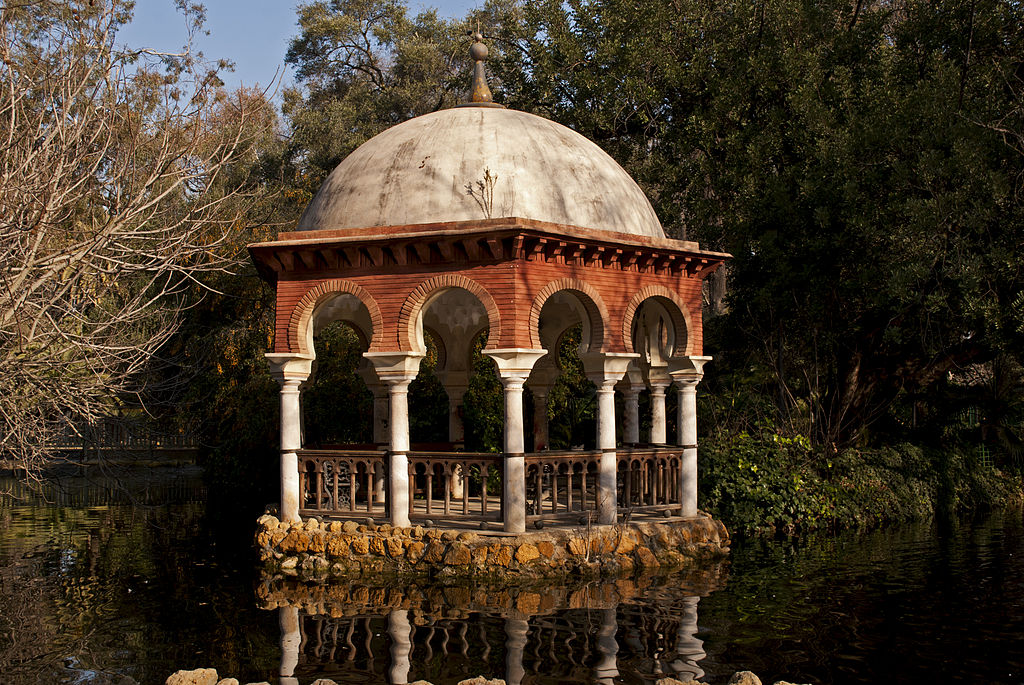

(left) Photo by Anual from Wikimedia Commons
Today one of the most lasting monuments left from the Ibero-American Exposition is the Parque de María Luisa. It is one of Seville’s largest greenspaces, and its home to many different fountains, gardens, and pavilions. The park is a popular hangout spot for both locals and tourists, and it showcases many of the various species of flora and fauna that can be found in Andalusia.
7. Hotel Alfonso XIII

The Ibero-American Exposition of 1929 was such a big event, that even the King of Spain Alfonso XIII was in attendance. In the years leading up to the exhibition, work began on the Hotel Alfonso XIII. The hotel was designed as an ultra-luxurious palace for the event’s wealthiest attendees to stay. The building contains an eclectic blend of architectural styles, with features from Mudejar Architecture blended seamlessly with Renaissance and Moorish elements.
Modern Architecture in Seville
Modern-day Seville has spread out dramatically past the ancient historic core. Today it is home to more than 700,000 people and is the fourth largest city in Spain. Seville has a very modern infrastructure system, and many of its newer bridges and metro stations were completed in preparation for the Seville Expo of 1992. Seville is also home to a variety of newer residential and office complexes, many of which are located north of the city center across the Guadalquivir River. The city is also home to Seville Tower, the tallest building in all of Andalusia.

Map of Seville highlighting various works of Modern Architecture within the city.
1. Las Setas
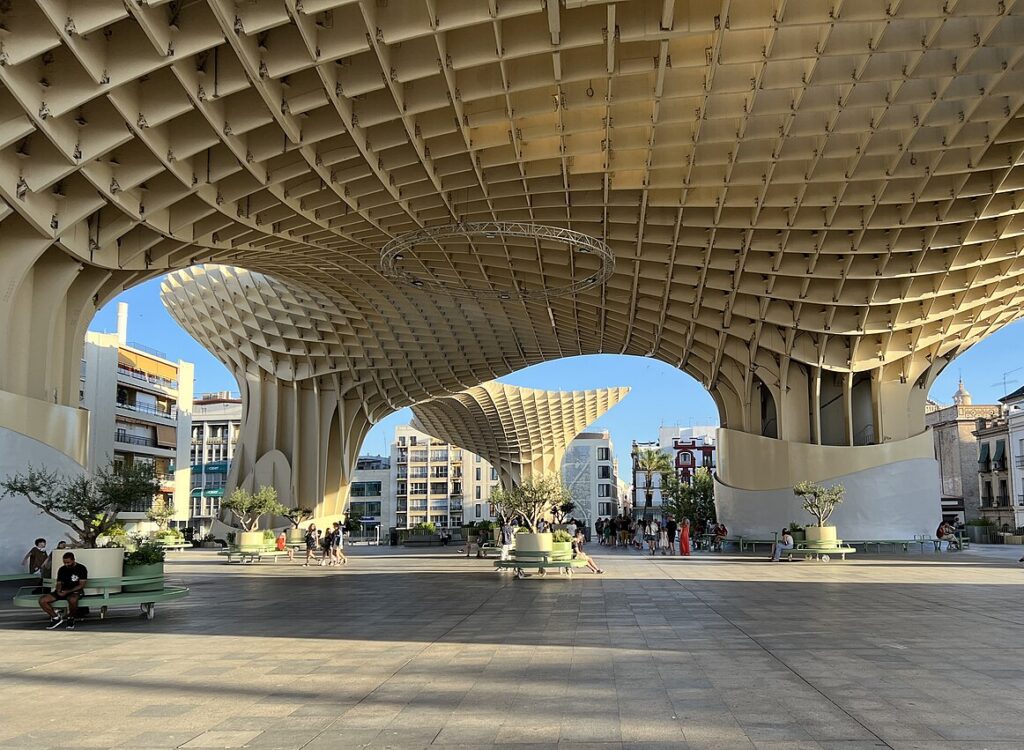
The most recognizable piece of modern architecture in Seville is known as Las Setas, or “the mushrooms.” Locals gave the structure this nickname as its wooden canopy resembles a naturally occurring fungus. The structure was completed in 2011 and is composed of thousands of uniquely carved wood pieces. Las Setas was built in an attempt to revitalize the Plaza de la Encarnación, which had been used as more of a parking lot than a public square since the 1960s.
2. Alamillo Bridge
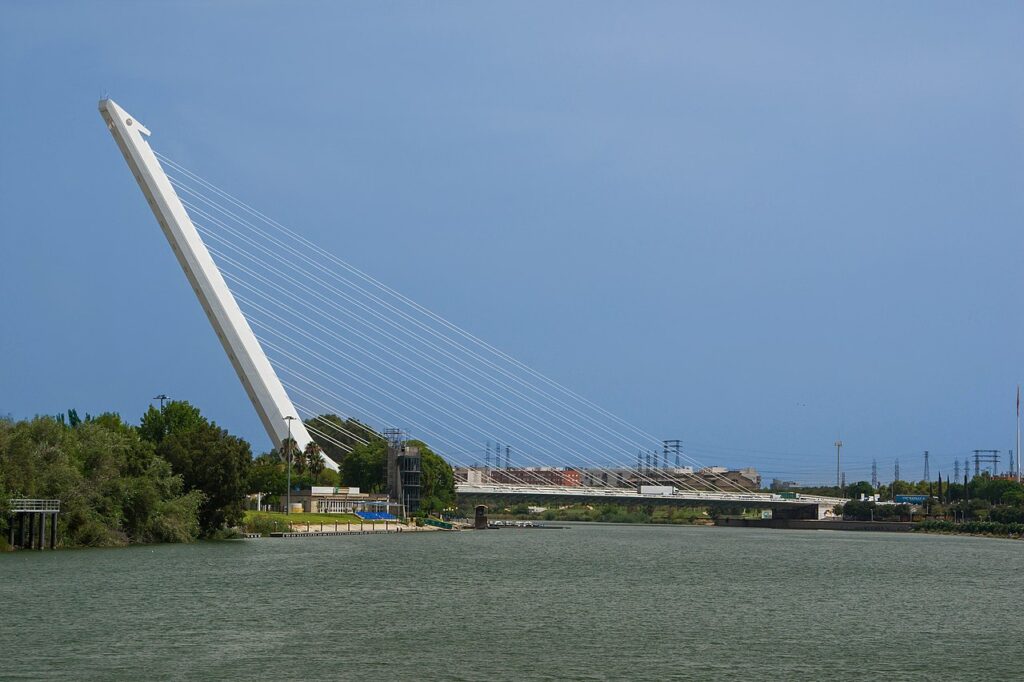
One of the most notable landmarks constructed for the Seville Expo of 1992 was the Alamillo Bridge. It was designed by one of Spain’s most notable architects & engineers, Santiago Calatrava. Calatrava is known for his modern and innovative approach to designing bridges. The Alamillo Bridge has a multi-lane roadway that is supported by just one individual tower. There are many similar structures throughout Spain, particularly in Valencia, the hometown of Calatrava.
3. Seville Tower

One other great example of Modern Architecture in Seville is Seville Tower. It is currently the tallest building in all of Andalusia, a title that it has held since construction ended in 2015. Seville Tower contains a plethora of office space, which has led to a significant amount of economic growth for the whole city. The tower is located north of Seville’s historic center, across the banks of the Guadalquivir River.
4. Expo 92′


Many of the buildings and pavilions from the Seville Expo of 92′ can still be visited today. The exposition was held on a strip of land just north of the Tirana Neighborhood, across the Guadalquivir from central Seville. The left image above shows the Avenue of Europe, a focal point of the exposition. The avenue features a central tower that combines many flags representing various European nations.
Neighborhoods of Seville
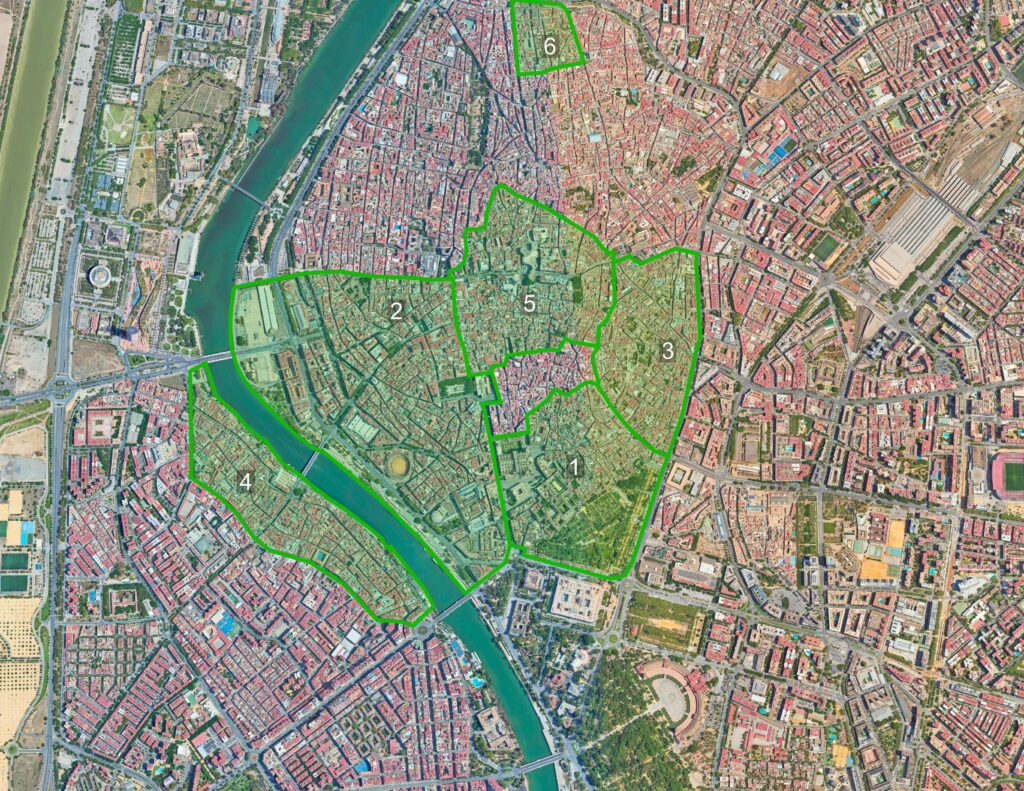
Map of Seville showing the extent of various neighborhoods within the city
.

1. Santa Cruz
Santa Cruz is often regarded as the most beautiful and quintessential Sevillian neighborhood. It was once known as the city’s “Jewish Quarter” and it’s home to an assortment of narrow streets and historic buildings. Santa Cruz is one of the busiest areas of Seville, and it contains many popular bars and restaurants. Santa Cruz also holds some of Seville’s most impressive works of Architecture, like the Cathedral and the Alcazar.

2. Museo
The area around Seville’s Museum of Fine Arts is known as the Museo Neighborhood. While still being central, this neighborhood is quieter and more residential than Santa Cruz. The Museo neighborhood also has a lot of nightlife and retailers.
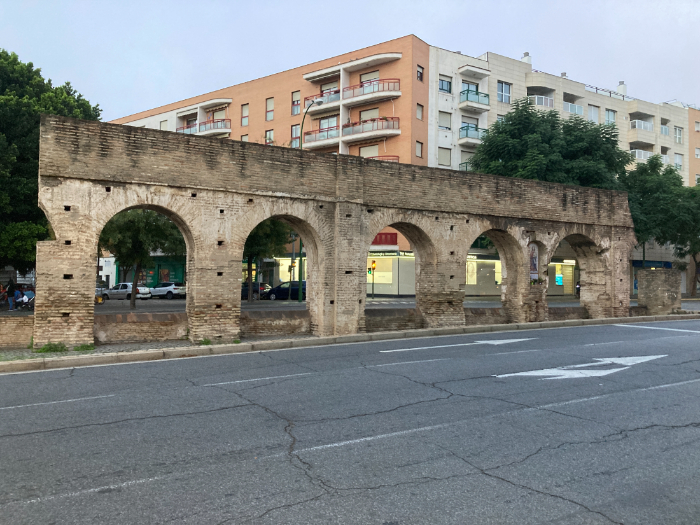
3. Puerta Carmona
Located on the Eastern edge of Seville’s historic Center, the Puerta Carmona neighborhood is a more residential area. Many locals live and work here, and the neighborhood gets its name from the gateway that once led to the nearby city of Carmona.
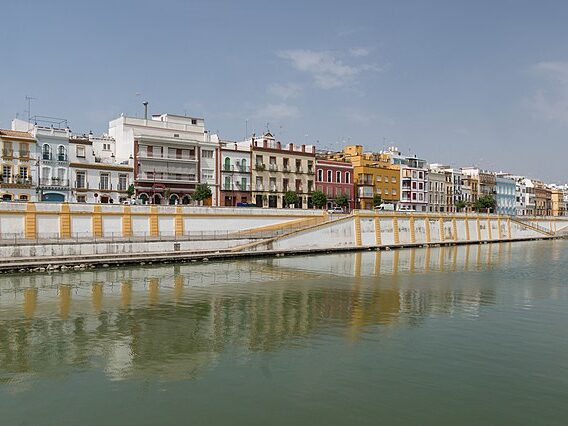
4. Tirana
Tirana is a traditional residential neighborhood located right across the banks of the Guadalquivir River. Although it once was the home of sailors and other merchants, today Tirana contains some of Seville’s most exclusive real estate. Tirana is also home to the Tirana Market, and its waterfront promenade is a major attraction.
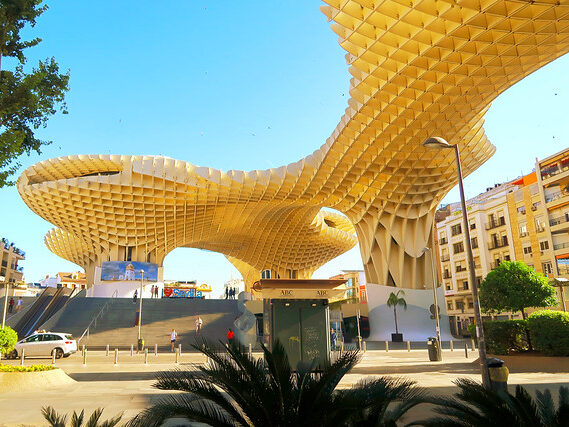
5. Las Setas
Las Setas is another neighborhood in Seville that is situated around the Les Setas Monument. Similar to Puerta de Carmona, this neighborhood is mostly residential. It’s home to many important landmarks and churches, and it has many pedestrian-only streets.

6. Macarena
Macarena is a neighborhood located on the Northern Edge of Seville. It’s named for the infamous Basílica de la Macarena. This area is also home to many other impressive sites, like some remnants of the Moorish Walls and the Andalusian Parliament Building. The Macarena neighborhood is also the starting point for many of Seville’s religious processions, which typically travel south towards the Cathedral.
Architecture of Seville: In Review
From the Romans to the Moors, to the Spanish Empire, and on to modern Spain – Seville showcases many impressive works of architecture from various ages. All of these cultures have left a lasting effect on Seville, making it the incredible city it is today. Seville is home to the world’s Largest Gothic Cathedral, as well as some of the best-preserved Moorish Monuments in all of Spain. Seville has hosted important events like the Ibero-American Exhibition, which have helped shape the city’s architecture and infrastructure. Seville is one of the top destinations in Europe for any architectural enthusiast, and many people use Seville as a starting point for other adventures throughout the region of Andalusia.
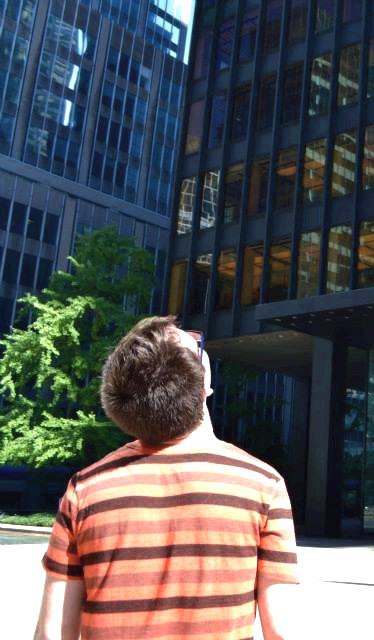
- About the Author
- Rob Carney, the founder and lead writer for Architecture of Cities has been studying the history of architecture for over 15 years.
- He is an avid traveler and photographer, and he is passionate about buildings and building history.
- Rob has a B.S. and a Master’s degree in Architecture and has worked as an architect and engineer in the Boston area for 10 years.
Like Architecture of Cities? Sign up for our mailing list to get updates on our latest articles and other information related to Architectural History.
